Savvas Learning Co Geometry Student Edition Chapter 8 Right Triangles And Trigonometry Exercise 8.1 The Pythagorean Theorem And Its Converse
Page 495 Exercise 1 Problem 1
Given:
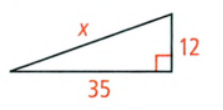
To find – The value of the variable.
Using the Pythagorean theorem find the value of the given variable.
We have
x2 = 352 + 122
x2 = 1225 + 144
x2 = 1369
x = \(\sqrt{1369}\)
x = 37
The value is x = 37.
Page 495 Exercise 2 Problem 2
Given:

To find – The value of the variable.
Using the Pythagorean theorem find the value of the given variable.
We have
x2 = 92 + 72
x2 = 81 + 49
x = \(\sqrt{130}\)
x ≈ 11.40
The value is x ≈ 11.40
Page 495 Exercise 3 Problem 3
Given:
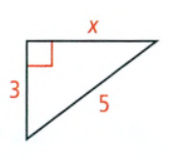
To find – The value of the variable.
Using the Pythagorean theorem find the value of the given variable.
We have
x2 = 52 − 32
x2 = 25 − 9
x = \(\sqrt{16}\)
x = 4
The value is x = 4.
Page 495 Exercise 4 Problem 4
Given:

To find – The value of the variable.
Using the Pythagorean theorem find the value of the given variable.
We have
x2 = 132 − 112
x2 = 169 − 121
x = \(\sqrt{48}\)
x = 4\(\sqrt{3}\).
The value is x = 4\(\sqrt{3}\).
Page 495 Exercise 5 Problem 5
Given: Describe the conditions that a set of three numbers must meet in order to form a Pythagorean triple.
To find – The condition for a Pythagorean triple.
The condition that must be met for three numbers to form a Pythagorean triple is that the sum of the squares of the two numbers should be equal to the square of the third number.
The condition that must be met for three numbers to form a Pythagorean triple is that the sum of the squares of the two numbers should be equal to the square of the third number.
Page 495 Exercise 6 Problem 6
Given:
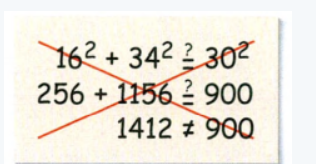
To find – Describe the error.
Friend made a mistake in choosing the hypotenuse. Instead of 30,34 should have been chosen for the hypotenuse.
Choose 34 as hypotenuse, and 16,30 for legs.
We have
162 + 302 = 342
256 + 900 = 1156
1156 = 1156
The friend made a mistake in choosing the hypotenuse. Instead of 30,34 should have been chosen for the hypotenuse. We see that the sum of the squares of the lengths of the legs is equal to the square of the hypotenuse. So the triangle is a right-angled triangle.
Page 495 Exercise 7 Problem 7
Given:
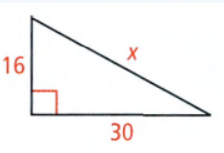
To find – The value of the variable.
Using the Pythagorean theorem find the value of the given variable.
We have
x2 = 162 + 302
x2 = 256 + 900
x2 = 1156
x = \(\sqrt{1156}\)
x = 34
The value is x = 34.
Page 495 Exercise 8 Problem 8
Given: A right-angle triangle

To Find – The value of x
We have, a or leg1 = 16 and b or leg2 = 12
So by applying the Pythagorean theorem
⇒ a2 + b2 = x2
⇒ 162 + 122 = x2
⇒ 256 + 144 = x2
⇒ 400 = x2
⇒ \(\sqrt{400}\)
= \(\sqrt{x^2}\) (Take positive square root)
⇒ x = 20
So the length of the hypotenuse or the value of x is 20.
The length of the hypotenuse (value of x) of a right-angle triangle with the other two sides being 16 and 12 is 20.
Page 495 Exercise 9 Problem 9
Given: A right-angle triangle

To Find – The value of x
We have, a or leg1 = 65 and b or leg2 = 72
So by applying the Pythagorean theorem
⇒ a2 + b2 = x2
⇒ 652 + 722 = x2
⇒ 4225 + 5184 = x2
⇒ 9409 = x2
⇒ x = 97 (Take positive square root)
So the value of x is 97.
The length of the hypotenuse (value of x) of a right-angle triangle with the other two sides being 65 and 72 is 97.
Page 495 Exercise 10 Problem 10
Given: A right-angle triangle

To Find – The value of x
We have, a or leg1 = 15 and b or leg2 = 8
So by applying the Pythagorean theorem
⇒ a2 + b2 = x2
⇒ 152 + 82 = x2
⇒ 225 + 64 = x2
⇒ 289 = x2
⇒ x = 17 (Take positive square root)
So the value of x is 17.
The length of the hypotenuse (value of x) of a right-angle triangle with the other two sides being 15 and 8 is 17.
Page 495 Exercise 11 Problem 11
Given: A set of numbers- 4, 5, 6
To Find – Does the set of numbers form a Pythagorean triple
We have, a set of whole numbers- 4, 5, 6
Let, a = 4, b = 5, c = 6
Substituting the value of a, b, and c in a2 + b2 = c2
⇒ 42 + 52 = 62
⇒ 16 + 25 = 36
⇒ 41 ≠ 36
As L.H.S. is not equal to R.H.S., therefore, the sets 4, 5, 6 do not satisfy the equation a2 + b2 = c2
So the set 4, 5, 6 is not a Pythagorean triple.
The set of numbers 4, 5, 6 is not a Pythagorean triple as it does not satisfy the equation a2 + b2 = c2.
Page 495 Exercise 12 Problem 12
Given: A set of numbers- 10, 24, 26.
To Find – Does the given set of numbers form a Pythagorean triple
We have, a set of numbers- 10, 24, 26
Let, a = 10,b = 24, c = 26
Substituting the values of a, b, c in the equation a2 + b2 = c2
⇒ a2 + b2 = c2
⇒ 102 + 242 = 262
⇒ 100 + 576 = 676
⇒ 676 = 676
As L.H.S. is equal to R.H.S. therefore, the set of numbers 10, 24, 26 satisfy the equation a2 + b2 = c2
Hence, the set of numbers 10, 24, 26 is a Pythagorean triple.
The set of numbers 10, 24, 26 is a Pythagorean triple because it satisfies the equation a2 + b2 = c2
Page 495 Exercise 13 Problem 13
Given: A set of numbers- 10, 24, 26.
To Find – Does the given set of numbers form a Pythagorean triple
We have, a set of numbers- 10, 24, 26
Let, a = 10, b = 24, c = 26
Substituting the values of a, b, and c in the equation a2 + b2 = c2
⇒ a2 + b2 = c2
⇒ 102 + 242 = 262
⇒ 100 + 576 = 676
⇒ 676 = 676
As L.H.S. is equal to R.H.S., therefore, the set of numbers 10, 24, 26 satisfies the equation a2 + b2 = c2
Hence, the set of numbers 10, 24, 26 is a Pythagorean Triple.
The set of numbers 10, 24, 26 is a Pythagorean triple because it satisfies the equation a2+ b2 = c2.
Page 496 Exercise 14 Problem 14
Given: A set of numbers- 15, 20, 25
To Find – Does the given set of numbers form a Pythagorean triple
We have, a set of numbers- 15, 20, 25
Let, a = 15,b = 20,c = 25
Substituting the values of a, b, c in the equation a2 + b2 = c2
⇒ a2 + b2 = c2
⇒ 152 + 202 = 252
⇒ 225 + 400 = 625
⇒ 625 = 625
As L.H.S. is equal to R.H.S., therefore, the set of numbers 15, 20, 25 satisfies the equation a2 + b2 = c2
Hence, the set of numbers 15, 20, 25 is a Pythagorean Triple.
The set of numbers 15, 20, 25 is a Pythagorean Triple because it satisfies the equation a2 + b2 = c2
Page 496 Exercise 15 Problem 15
Given: A right-angle triangle with two sides

To Find – The value of x
In the given right-angle triangle
Base (a) = x units
Height (b) = 4 units
Hypotenuse (c) = 6 units
(leg1 )2+(leg2)2 = (Hypotenuse)2 (Pythagorean theorem)
Substitute the values of a, b, c in the Pythagorean Theorem
⇒ a2 + b2 = c2
⇒ x 2+ 42 = 62
⇒ x2 + 16 = 36
⇒ x2 + 16 − 16 = 36 − 16
⇒ x2 = 20
⇒ x = \(\sqrt{20}\)
⇒ x = \(\sqrt{4(5)}\)
⇒ x = 2\(\sqrt{5}\)
The value of x in the simplest radical form is 2\(\sqrt{5}\).
Page 496 Exercise 16 Problem 16
Given: A right-angle triangle with two sides
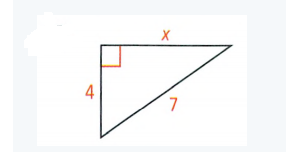
To Find – The value of x in simplest radical form
In the given right-angle triangle
Base (a) = x units
Height (b) = 4 units
Hypotenuse (c) = 7 units
Substituting the values in the Pythagorean theorem
(leg1)2 + (leg2)2 =(Hypotenuse)2
⇒ x2 + 42 = 72
⇒ x2 + 16 = 49
⇒ x2 + 16 − 16 = 49 − 16
⇒ x2 = 33
⇒ x = \(\sqrt{33}\)
The value of x in the simplest radical form is \(\sqrt{33}\).
Page 496 Exercise 17 Problem 17
Given: A right-angle triangle with two sides

To Find – The value of x in simplest radical form
In the given right-angle triangle
leg1 = 16, leg2 = x, Hypotenuse = 19
Substituting the values in the Pythagorean Theorem
(leg1)2 +(leg2)2 = (Hypotenuse)2
⇒ 162 + x2 = 192
⇒ 256 + x2 = 361
⇒ x2 = 361 − 256
⇒ x2 = 105
⇒ x = \(\sqrt{105}\)
The value of x in the simplest radical form is \(\sqrt{105}\).
Page 496 Exercise 18 Problem 18
Given: A right-angle triangle

To Find – The value of x in simplest radical form
In the given right-angle triangle
leg1 = x, leg2 = x, Hypotenuse = 6
Substituting the values in the Pythagorean Theorem
⇒ (leg1)2 + (leg2 )2 = (Hypotenuse)
⇒ x2 + x2 = 62
⇒ 2x2 = 36
⇒ \(\frac{2 x^2}{2}=\frac{36}{2}\)
⇒ x2 = 18
⇒ x = \(\sqrt{18}\)
⇒ x = \(\sqrt{9(2)}\)
⇒ x = 3\(\sqrt{2}\)
The value of x in the simplest radical form is 3\(\sqrt{2}\)
Page 496 Exercise 19 Problem 19
Given: A right-angle triangle
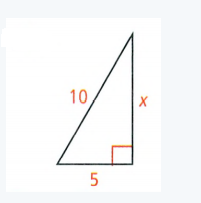
To find – The value of x in the simplest radical form
In the given right-angle triangle
leg1 = 5, leg2 = x , Hypotenuse = 10
Substituting the values in the Pythagorean Theorem
⇒ (leg1)2 + (leg2)2 = (Hypotenuse)2
⇒ 52 + x2 = 102
⇒ 25 + x2 = 100
⇒ 25 − 25 + x2 = 100 − 25
⇒ x2 = 75
⇒ x = \(\sqrt{75}\)
⇒ x = \(\sqrt{25(3)}\)
⇒ x = 5\(\sqrt{3}\)
The value of x in the simplest radical form is 5\(\sqrt{3}\).
Page 496 Exercise 20 Problem 20
Given: Length of the ladder is 15 -ft, Base of the ladder from the house is 5 -ft
To Find – Height on the house that the ladder reach
As the ladder is leaning against the house so the height of the ladder will be the hypotenuse, i.e., 15 − ft.
The base of the ladder is 5 ft from the house, so the base will be 5 ft. b = 5ft
Let the height on the house that the ladder reach be x ft.
So according to the Pythagorean Theorem
⇒ Base2+ Height2 = Hypotenuse2
⇒ 52 + x2 = 152
⇒ 25 + x2 = 225
⇒ x2 = 225 − 25
⇒ x = \(\sqrt{200}\)
⇒ x = 14.142
⇒ x = 14.1ft (Roud off to nearest tenth)
Hence the height on the house that the ladder reach is 14.1 ft.
When a 15 − ft ladder leans against the house and the base of the ladder is 5 − ft from the house then the height on the house that the ladder reach is 14.1 ft.
Page 496 Exercise 21 Problem 21
Given: A 24 m long walkway forms a diagonal of a square playground.
To Find – Length of a side of the playground
As the walkway divides the square into two right-angle triangles, and the walkway (Diagonal) is 24 m long so the Pythagorean Theorem can be applied.

As each side of a square is equal so let leg1 = leg2 = x meters and the walkway will be the hypotenuse.
Substituting the values in the Pythagorean Theorem
⇒ (leg1)2 + (leg2)2 = (hypotenuse)2
⇒ x2 + x2 = 242
⇒ 2x2 = 576
⇒ \(\frac{2 x^2}{2}=\frac{576}{2}\)
⇒ x2 = 288
⇒ x = \(\sqrt{288}\)
⇒ x≈16.97
⇒ x≈17.0 meters (Round off)
Hence, the length of each side of the playground is approximately 17 meters.
If a 24 m walkway forms one diagonal of a square playground then, the length of a side of the playground is approximately 17 meters.

Page 496 Exercise 22 Problem 22
Given: A triangle

To Find – If the triangle is a right-triangle
Hypotenuse = 25, leg1 = 24, leg2 = 8
For checking, if the triangle is a right triangle apply the Pythagorean theorem
⇒ (leg1)2 + (leg2 )2 = (Hypotenuse)2
⇒ 242 + 82 = 252
⇒ 576 + 64 = 625
⇒ 640 ≠ 625
As L.H.S. is not equal to R.H.S., therefore it does not satisfy the Pythagorean Theorem and hence it is not a right triangle.
The triangle is not a right triangle because it does not satisfy the Pythagorean theorem, 242 + 82 ≠252.
Page 496 Exercise 23 Problem 23
Given: The triangle.

To Find – If the triangle is a right-angled triangle or not.
Using the Pythagoras theorem, we will find if the triangle is a right-angled triangle.
Consider the triangle

Pythagoras theorem states that the square of the hypotenuse is equal to the sum of the squares of other sides.
Let,c = 65, a = 56 , b = 33
Now, using Pythagoras theorem:
c2 = 652
c2 = 4225
And,a2 + b2 = 562 + 332
a2 + b2 = 4225.
Since,c2 = a2 + b2 the triangle is a right-angled triangle.
The triangle is a right triangle.
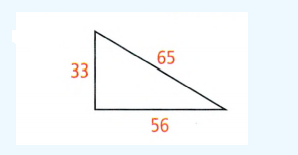
Page 496 Exercise 24 Problem 24
Given: The lengths of the sides of a triangle are 4,5,6.
To Find – The type of triangle.
In order to determine the type of triangle, we need to observe the inequality of the Pythagoras theorem
Consider the lengths of the three sides of a triangle , 4,5,6
Now, if a2 + b2 = c2 the triangle is a right angle, if a2 + b2 > c2 triangle is acute, if a2 + b2 < c2 triangle is obtuse.
Now, the highest length is the hypotenuse.
So, a = 4 , b = 5 , c = 6
So, a2 + b2 = 42 + 52
a2 + b2 =16 + 25
a2 + b2 = 41
c2 = 62
c2 = 36.
As a2 + b2 >c2 the triangle is an acute triangle.
Page 496 Exercise 25 Problem 25
Given: The length of the sides of a triangle is 0.3,0.4,0.6 .
To Find – The type of triangle.
In order to determine the type of triangle, we need to observe the inequality of the Pythagoras theorem.
Consider the lengths of the three sides of a triangle , 0.3,0.4,0.6.
Now, if a2 + b2 = c2 the triangle is a right triangle, if a2 + b2 > c2 triangle is acute, if a2 + b2 < c2 triangle is obtuse.
The highest length is the hypotenuse. So,a = 0.3 b = 0.4 c = 0.6
Now,a2 + b2 = 0.32 + 0.42
a2 + b2 = 0.25 and c2 = 0.62
c2 = 0.36
As a2 + b2 <c2 the triangle is an obtuse triangle.
The triangle with lengths with sides 0.3,0.4,0.6 is an obtuse triangle.
Page 496 Exercise 26 Problem 26
Given: The length of the sides of a triangle is11,12,15.
To Find – The type of triangle.
In order to determine the type of triangle, we need to observe the inequality of the Pythagoras theorem.
Consider the sides of the triangle , 11,12,15.
Now, if a2 + b2 = c2 the triangle is a right-angle triangle, if a2 +b2 > c2 triangle is acute, if a2+ b2 <c2 triangle is obtuse.
The highest length is the hypotenuse. So,a = 11 b = 12 c = 15
So,a2 + b2 = 112 + 122
a2 + b2 = 121 + 144
a2 + b2 = 265.
And,c2= 152
c2 = 225
As a2 + b2 > c2 the triangle is an acute triangle.
The triangle with lengths of sides 11,12,15 is an acute triangle.
Page 496 Exercise 27 Problem 27
Given: The length of the sides of a triangle is \(\sqrt{3}\),2,3.
To find – The type of triangle.
In order to determine the type of triangle, we need to observe the inequality of the Pythagoras theorem.
Consider the sides of the triangle , \(\sqrt{3}\),2,3.
Now, if a2 + b2 = c2 triangle is a right angle triangle, if a2 + b2 > c2 the triangle is an acute triangle and if a2 + b2 < c2 the triangle is an obtuse triangle.
The highest length in a triangle is the hypotenuse.
So, a = \(\sqrt{3}\) , b= 2, c= 3
Now, a2 + b2 = 7 and
c2 = 32
c2 = 9
As a2 + b2 < c2 the triangle is an obtuse triangle.
The triangle with the sides \(\sqrt{3}\) ,2,3 is an obtuse triangle.
